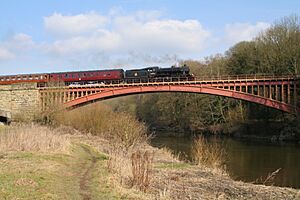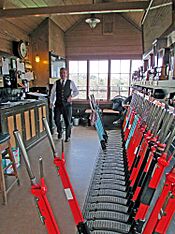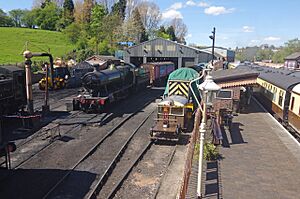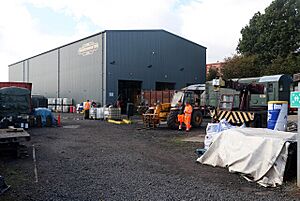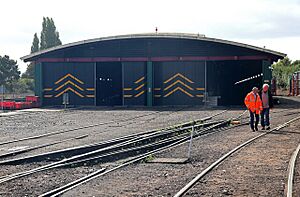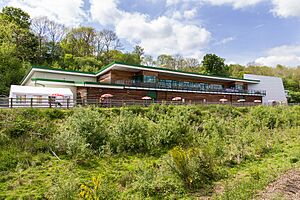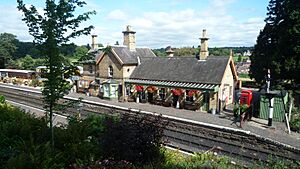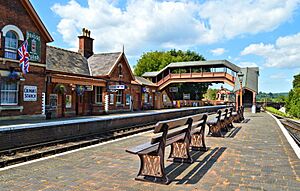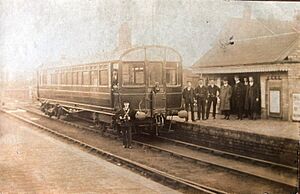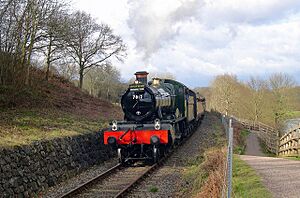Severn Valley Railway facts for kids
Quick facts for kids Severn Valley Railway |
|
|---|---|

GWR 5101 Class large prairie 5164 leaving Highley railway station on the SVR.
|
|
| Locale | Worcestershire and Shropshire |
| Terminus | Kidderminster, Bridgnorth |
| Commercial operations | |
| Name | Severn Valley Line |
| Built by | Severn Valley Railway |
| Original gauge | 4 ft 8 1⁄2 in (1,435 mm) standard gauge |
| Preserved operations | |
| Operated by | Severn Valley Railway (Holdings) plc |
| Stations | 9 (including 3 "halts") |
| Length | 16 miles (26 km) |
| Preserved gauge | 4 ft 8 1⁄2 in (1,435 mm) standard gauge |
| Commercial history | |
| Opened | 1 February 1862 |
| Closed | January 1970 (Bewdley Station) |
| Preservation history | |
| 1965 | Severn Valley Railway Preservation Society formed |
| 1970 | Severn Valley Railway granted Light Railway Order |
| 1970 | Bridgnorth – Hampton Loade reopened |
| 1974 | Hampton Loade – Bewdley reopened |
| 1984 | Bewdley – Kidderminster reopened |
| Headquarters | Kidderminster |
The Severn Valley Railway is a special old railway in Shropshire and Worcestershire, England. It's called a heritage railway because it keeps old trains and tracks working. This single track line is about 16-mile (26 km) long. It runs from Bridgnorth to Kidderminster. Along the way, it stops at four main stations and three smaller "halts" (stops you have to ask for). The railway follows the beautiful River Severn for most of its journey. It even crosses the river on the famous Victoria Bridge.
You can ride on trains pulled by old steam engines or classic diesel locomotives. The carriages are often restored old ones, making you feel like you've stepped back in time! Sometimes, special freight trains run too. The railway is usually open on weekends and holidays during its season. It also hosts exciting events like steam and diesel galas, where you can see many different types of trains.
Contents
History of the Railway
How the Railway Started
| Severn Valley Railway Act 1853 | |
|---|---|
| Act of Parliament | |
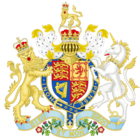
|
|
| Long title | An Act for making a Railway from the Oxford, Worcester, and Wolverhampton Railway near Hartlebury in the County of Worcester to the Borough of Shrewsbury in the County of Salop, with a Branch, to be called "The Severn Valley Railway;" and for other Purposes. |
| Citation | 16 & 17 Vict. c. ccxxvii |
| Dates | |
| Royal assent | 20 August 1853 |
| Other legislation | |
| Repealed by |
|
|
Status: Repealed
|
|
| Text of statute as originally enacted | |
| Severn Valley Railway Act 1855 | |
|---|---|
| Act of Parliament | |

|
|
| Long title | An Act for the making and maintaining of the Severn Valley Railway; and for other Purposes. |
| Citation | 18 & 19 Vict. c. clxxxiii |
| Dates | |
| Royal assent | 30 July 1855 |
| Other legislation | |
| Repeals/revokes |
|
| Text of statute as originally enacted | |
| Severn Valley Railway Act 1856 | |
|---|---|
| Act of Parliament | |

|
|
| Long title | An Act for authorizing Deviations from the authorized Line of the Severn Valley Railway, and for making further Provision with respect to Shares in the Capital of the Severn Valley Railway Company, and for facilitating the Completion of their Undertaking, and for other Purposes. |
| Citation | 19 & 20 Vict. c. cxi |
| Dates | |
| Royal assent | 21 July 1856 |
| Text of statute as originally enacted | |
| Severn Valley Railway Act 1858 | |
|---|---|
| Act of Parliament | |

|
|
| Long title | An Act for making further Provision with respect to the Severn Valley Railway, in order to the Completion thereof; and for other Purposes. |
| Citation | 21 & 22 Vict. c. cxxxv |
| Dates | |
| Royal assent | 23 July 1858 |
| Severn Valley Railway (Leasing) Act 1860 | |
|---|---|
| Act of Parliament | |

|
|
| Long title | An Act to enable the Oxford, Worcester, and Wolverhampton Railway Company to take on Lease the Undertaking of the Severn Valley Railway Company. |
| Citation | 23 & 24 Vict. c. lxxvi |
| Dates | |
| Royal assent | 14 June 1860 |
| Text of statute as originally enacted | |
| West Midland and Severn Valley Railways Act 1862 | |
|---|---|
| Act of Parliament | |

|
|
| Long title | An Act to authorize an Alteration of the Terms of the Lease of the Severn Valley Railway to the West Midland Railway Company; and for other Purposes. |
| Citation | 25 & 26 Vict. c. clxxxiii |
| Dates | |
| Royal assent | 29 July 1862 |
| Text of statute as originally enacted | |
| Severn Valley Railway Act 1864 | |
|---|---|
| Act of Parliament | |

|
|
| Long title | An Act to authorize the Severn Valley Railway Company to raise further Sums of Money, and to make certain Works in connexion with their Railway; and for other Purposes. |
| Citation | 27 & 28 Vict. c. cli |
| Dates | |
| Royal assent | 30 June 1864 |
| Text of statute as originally enacted | |
The Severn Valley Railway was built between 1858 and 1862. It connected Hartlebury, near Droitwich Spa, with Shrewsbury. This was a long journey of about 40 miles (64 km). Important stops included Bewdley and Bridgnorth.
Even though the Severn Valley Railway Company built the line, another company ran it. The West Midland Railway operated it from its opening on February 1, 1862. Later, the famous Great Western Railway (GWR) took over in 1863. The GWR called it the Severn Valley Branch. The railway was built wide enough for two tracks, but only one was laid to save money. This meant it could be expanded later, but it never was.
In 1878, the GWR added a new line between Bewdley and Kidderminster. This allowed trains to travel directly from the Black Country to Shropshire. This new section is now part of the preserved railway. The original line through Stourport was removed.
For most of its working life, the Severn Valley line was run by the Great Western Railway. Today, it's mainly a heritage passenger railway. This means it focuses on preserving railway history for visitors.
Why the Railway Closed
The Severn Valley line was never very profitable. It mostly carried farm goods and coal from local mines. Fewer people started using the trains after the First World War. Even adding small "halts" in the 1930s didn't help much. However, the line was useful during the Second World War. It served as an alternative route if other main lines were busy or damaged.
After British railways became nationalised in 1948, even fewer passengers used the line. The Severn Valley Branch was scheduled to close before the famous "Beeching cuts" report in 1963. British Railways announced its closure plans in 1962. Despite objections, the line between Shrewsbury and Bewdley closed to passengers in September 1963. Freight services also stopped in November 1963. The tracks north of Bridgnorth were then removed.
The line from Bewdley continued to serve Alveley Colliery until 1969. A small passenger service also ran between Bewdley, Kidderminster, and Hartlebury until January 1970. Freight trains continued between a sugar factory and Kidderminster until 1982.
Bringing the Railway Back to Life
| British Railways Board (Severn Valley) Light Railway Order 1970 | |
|---|---|
| Statutory Instrument | |
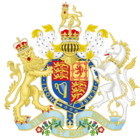
|
|
| Citation | SI 1970/7 |
| Dates | |
| Made | 5 January 1970 |
| Commencement | 16 January 1970 |
| British Railways Board (Severn Valley) Light Railway (Transfer) Order 1970 | |
|---|---|
| Statutory Instrument | |

|
|
| Citation | SI 1970/778 |
| Dates | |
| Made | 20 May 1970 |
| Commencement | 21 May 1970 |
| British Railways Board (Severn Valley) Light Railway Order 1973 | |
|---|---|
| Statutory Instrument | |

|
|
| Citation | SI 1973/357 |
| Dates | |
| Made | 27 February 1973 |
| Commencement | 28 February 1973 |
| Other legislation | |
| Made under |
|
| Text of statute as originally enacted | |
| Severn Valley Light Railway (Transfer) Order 1974 | |
|---|---|
| Statutory Instrument | |

|
|
| Citation | SI 1974/642 |
| Dates | |
| Made | 28 March 1874 |
| Commencement | 29 March 1874 |
| Other legislation | |
| Made under |
|
| Text of statute as originally enacted | |
| British Railways Board (Severn Valley) Light Railway (Transfer) Order 1974 | |
|---|---|
| Statutory Instrument | |

|
|
| Citation | SI 1974/643 |
| Dates | |
| Made | 28 March 1874 |
| Commencement | 29 March 1874 |
| Other legislation | |
| Made under |
|
| Text of statute as originally enacted | |
| Severn Valley Light Railway Order 1984 | |
|---|---|
| Statutory Instrument | |

|
|
| Citation | SI 1984/1202 |
| Dates | |
| Made | 20 July 1984 |
| Commencement | 21 July 1984 |
| Other legislation | |
| Made under |
|
| Text of statute as originally enacted | |
In July 1965, a group of people who wanted to save a part of the closed railway formed the Severn Valley Railway Society. British Railways, which owned the line, agreed to sell a 5.5-mile section between Bridgnorth and Alveley Colliery for £25,000 in 1966. The society paid a first deposit in 1967.
To legally run a railway, a company was needed. So, a new Severn Valley Railway Company was created in May 1967. Its goal was to "preserve, retain and restore" the railway from Bridgnorth to Kidderminster.
In May 1970, the railway received a special "Light Railway Order." This allowed regular train services to start between Bridgnorth and Hampton Loade. The rest of the £25,000 was paid to British Railways in June 1970.
When coal trains from the colliery stopped in 1969, the SVR bought another 8.5 miles of track. This section went from Hampton Loade to Foley Park in 1972. This cost £74,000, which was raised by selling shares to the public. There was a disagreement with the chairman, Sir Gerald Nabarro, who wanted to sell off parts of the railway land. Volunteers threatened to strike, and his plans were stopped. He left the company in 1973. Services were then extended to Bewdley in May 1974.
After freight trains from the British Sugar factory at Foley Park ended in 1982, the SVR bought the last section of the line to Kidderminster for £75,000. The SVR also rented the old goods yard at Kidderminster to build a new station. This new station opened, and services to Kidderminster began on July 30, 1984.
Since 1984, the SVR has made many improvements. These include a new signal box at Kidderminster in 1987 and a new boiler shop at Bridgnorth in 1990. They also bought the land for Kidderminster Town station in 1994. A new carriage shed opened in Kidderminster in 2003. The east wing of Kidderminster Station was finished in 2006. The Engine House Museum at Highley opened in 2008.
In 2010, the railway celebrated its 40th anniversary of opening. It also marked 175 years since the Great Western Railway was formed. In 2015, the SVR celebrated 50 years since its preservation society began. Special events were held to mark these important dates.
How the Railway Works Today
Train Services
The Severn Valley Railway usually runs passenger trains pulled by old steam or diesel engines. These trains travel the 16-mile (26 km) line between Kidderminster and Bridgnorth. They stop at all the stations along the way. The small "halts" (Northwood Halt, Country Park Halt, and Eardington Halt) are request stops. This means you need to tell the guard if you want to get off or wave to the driver if you want to get on. These halts are only used during daylight hours.
Trains usually run during school holidays and on weekends. Sometimes, you can even enjoy a special dining experience in the carriages. The railway also puts on many special events. These events are designed to attract different visitors and make the railway more popular.
Many special gala days are held for train fans. Often, other heritage railways send their engines and carriages to visit. These events and other attractions have helped visitor numbers grow to over 250,000 people each year.
In September 2023, the SVR announced a partnership with Network Rail. This means the SVR can get expert help, advice, and old railway materials from the main line. Network Rail employees also volunteer at the SVR on special days.
Special Mainline Trains
The SVR connects to Britain's main railway network at Kidderminster. This allows special trains from other parts of the country to visit Bridgnorth. These can include trains for track maintenance, weed killing, or measuring the tracks. Sometimes, passenger trains from the main line also visit.
Here are some examples:
- In May 2007, two freight trains carried long pipes from Kidderminster to a water plant at Trimpley.
- In 2009, two direct passenger trains ran from Bridgnorth to London Marylebone.
- In March 2021, the railway was used to test the first rebuilt Class 69 mainline locomotive.
- In September 2022, a special CrossCountry HST40 train tour visited the railway.
Railway Signals
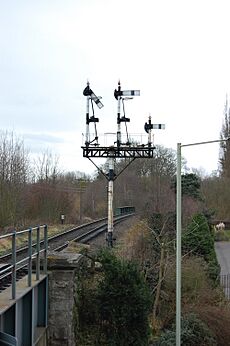
Except for the connection to the main line at Kidderminster, all the signals on the SVR are old Great Western Railway style. These are called "lower quadrant semaphore signals." They have arms that drop down to show if the track is clear.
Every main station has a signal box. Bewdley has two signal boxes because it was a very busy junction station.
Between Bridgnorth and Bewdley North, a special "Electric Train Token" system is used. This system ensures only one train is on a section of single track at a time. Signal boxes at Arley and Hampton Loade can be closed when not needed. This saves wear and tear and means fewer signal operators are required.
Bridgnorth also has a small control panel called a "ground frame" at its northern end. This allows trains to move into and out of the Boiler Shop. A special key is needed to unlock this frame.
The Engineer's siding at Eardington is also controlled by a ground frame. When this siding is used, the Hampton Loade signal box must be closed.
Between Bewdley North and Bewdley South, there are two tracks. This section uses a system called "absolute block signalling." The single track through platform 3 uses a "direction lever" system. The single track between Bewdley South and Kidderminster uses an "acceptance lever" system.
Most signal boxes have their original GWR name plates. The one at Bridgnorth is a replica. The Kidderminster SVR name plate came from another old signal box. The lever frame at Arley came from Yorton station.
Trains and Carriages
The SVR keeps, looks after, and restores many old passenger carriages and goods wagons. These are used for its regular train services. The railway also has a large collection of locomotives. Only a few trains belong to the railway company itself. Most are owned by special groups or individuals who love old trains.
For example, the Great Western (Severn Valley Railway) Association owns many trains. The West Midland Group focuses on preserving old diesel multiple units (DMUs). The Diesel Traction Group owns several of the SVR's heritage diesel locomotives. Trains from the SVR are sometimes used on the main national rail network for special trips.
Miniature Railways
The Coalyard Miniature Railway offers fun passenger rides at Kidderminster Town station. The Paddock Railway is a smaller model railway (1:19 scale) that runs most Sundays at Hampton Loade railway station. Both of these miniature railways are run by volunteers.
Looking After the Trains
Locomotive Workshops
The main workshops for locomotives are at Bridgnorth. For safety reasons, visitors usually can't go inside. However, special guided tours and open days happen sometimes.
The workshops have special equipment like lifting jacks and a wheel lathe. They also have a "wheel drop" from an old Leicester train depot. There's a boiler shop with a large crane for heavy lifting. The workshops were improved in 2009 with better lighting and doors. In 2022, they got a new overhead crane and a new roof. They also added eco-friendly features like LED lighting.
Diesel Engine Depot
Diesel locomotives are looked after at the traction maintenance depot in Kidderminster. This is also known as Kidderminster Diesel Depot. It's a building with three tracks, opened in 2016. It has a pit under the tracks and an overhead crane. This depot helps the SVR keep its diesel trains in good working order.
Carriage Workshops
Carriages are painted and restored in several places along the railway. However, the main repair workshop for carriages is in the old goods shed at Kidderminster. This shed is next to the main line from Birmingham to Worcester. The carriage works has machines and tools to fix all parts of the carriages. They can also check and repair brakes. Like the locomotive works, it's usually not open to the public for safety reasons.
Carriage Storage Shed
The Kidderminster carriage shed is a large, modern building with a grey roof. It's next to the railway line leaving Kidderminster. This shed is used to store, maintain, clean, and inspect the SVR's passenger carriages. It has six tracks, two of which are outside the main shed. It's almost a quarter of a mile long. It can hold up to 62 carriages. This is very useful for protecting the carriages from bad weather when they are not in use. It was built between 1999 and 2000 with £1.7 million from the Heritage Lottery Fund.
The Engine House Museum
The Engine House is a special building near Highley station. It provides a covered space to display locomotives that are not currently running. It also has exhibits about other rolling stock and a learning center. It is usually open to visitors when the railway is running trains. It's a popular attraction along the line.
Building the Engine House
The land where the Engine House stands was once used for Highley Colliery. Later, it was a yard for Alveley Colliery. The SVR had wanted to use this area to store and display locomotives since 1973. In 2001, the SVR bought the land with help from grants. Planning permission was given in 2004.
The Engine House was supposed to open in mid-2007. However, floods in Highley that year caused delays. It finally opened to the public on March 20, 2008. On the same day, full train services started again between Bridgnorth and Kidderminster. An official opening ceremony was held in April 2009. A second dedication, along with a new footbridge at Highley station, was performed by Prince Richard, Duke of Gloucester, in October 2009.
Stations Along the Line
Current Stations
| Point | Coordinates (Links to map resources) |
OS Grid Ref | Notes |
|---|---|---|---|
| Bridgnorth | 52°31′50″N 2°25′15″W / 52.5305°N 2.4208°W | This station building is a protected historic site. | |
| Eardington Halt | 52°30′06″N 2°24′00″W / 52.5017°N 2.4001°W | Originally just Eardington (closed in 1982, reopened in 2023). | |
| Hampton Loade | 52°28′26″N 2°22′38″W / 52.4738°N 2.3771°W | ||
| Country Park Halt | 52°27′18″N 2°22′33″W / 52.4549°N 2.3758°W | (Request stop) replaced Alveley Halt. | |
| Highley | 52°26′41″N 2°22′14″W / 52.4448°N 2.3705°W | ||
| Arley | 52°25′01″N 2°20′53″W / 52.4170°N 2.3480°W | ||
| Northwood Halt | 52°23′39″N 2°19′37″W / 52.3941°N 2.3270°W | (Request stop). | |
| Bewdley | 52°22′31″N 2°18′22″W / 52.3752°N 2.3061°W | ||
| Kidderminster Town | 52°23′03″N 2°14′24″W / 52.3842°N 2.2400°W | Not an original station, opened in 1984. |
All the main stations (not the halts) have loops where trains can pass each other on the single line. However, Highley's passing loop cannot be used by passenger trains. It is only for work trains or demonstration freight trains.
Kidderminster Town station is not an original station. The SVR built it in 1984 on an old goods yard site. Its design is based on the old GWR station at Ross-on-Wye. Volunteers and contractors have added many features since then. These include the grand entrance, decorative crests on the towers, and the canopy over the main area. The final east wing of the station was completed in 2006.
Plans for a big upgrade at Bridgnorth station were approved in 2016. These plans include a new cafe, car park, a turntable for locomotives, and places for volunteers to stay. These will be built when money is available.
Former Stations
Many stations on the original Severn Valley Railway closed in 1963. They were in use for 101 years. Most of these were not saved by the heritage railway. This was because tracks were removed in some areas.
- Between Hartlebury and Bewdley:
- Stourport-on-Severn (1862–1970)
- Burlish Halt (1930–1970)
- Between Kidderminster and Bridgnorth:
- Foley Park Halt (1905–1970)
- Rifle Range Halt (1905–1920)
- Alveley Halt (1944-1963)
- North of Bridgnorth:
- Linley Halt (1862–1963)
- Coalport West (1862–1963)
- Jackfield Halt (1934–1954) & (1954–1963) – This stop moved because of unstable ground.
- Ironbridge and Broseley (1862–1963)
- Buildwas Junction (1862–1963)
- Cressage (1862–1963)
- Cound Halt (1934–1963)
- Berrington (1862–1963)
Damage to the Railway
Big Floods in 2007
On June 19, 2007, huge thunderstorms caused massive damage to the railway. This was the worst damage in its history. Many landslides happened between Bridgnorth and Northwood Halt. Sections of track were left hanging in the air near Fisherman's Crossing and Highley. Part of the track by Oldbury viaduct was also washed away.
Many railway cuttings were filled with mud and debris. At Highley, a signal and its embankment were washed away by a rush of water. The road to Hampton Loade station was also destroyed.
The railway quickly launched an appeal to raise money for repairs. The total cost of the damage grew to about £3.7 million. This money came from grants, insurance, and public donations. Many other heritage railways also offered to help.
The floods badly affected tourism for the railway and local towns. The railway hoped to reopen some sections quickly. However, more heavy rain in July caused even more damage. It became clear that repairs would take much longer. The important section between Hampton Loade and Arley, including Highley station and the new Engine House museum, did not open until Spring 2008.
The Bridgnorth to Hampton Loade section finally reopened on February 9, 2008. The entire line between Kidderminster and Bridgnorth fully reopened on Good Friday, March 21, 2008. The repair work added many new drainage pipes under the line. There were 144 culverts after the floods, compared to 44 before.
Landslip in 2025
On January 30, 2025, a landslip happened between Hampton Loade and Bridgnorth stations. It was just north of Sterns. A wall of a small bridge over Mor Brook collapsed. This caused the railway embankment to slide into the brook. This made that part of the line unusable.
As a result, Bridgnorth was cut off from the rest of the railway. All the steam locomotives were stuck at the workshops next to the station. Resources like their coal supply could not be reached by train.
By April 2025, the SVR had talked with insurance companies and contractors. They had also raised £125,000 for the repairs. Repairs started in late May 2025. Workers built a new retaining wall using over 100 large concrete blocks. The full line reopened on July 26, 2025. The famous Flying Scotsman pulled the reopening train.
Future Plans for the Railway
Going North
Extending the railway north from Bridgnorth was discussed as early as the 1970s. However, these plans were often dismissed as impossible. For many years, the SVR website stated that the land north of Bridgnorth had been sold. This meant trains could not reach Ironbridge and Shrewsbury again. In 2002, the railway board said they would look into any studies about restoring rail links to Ironbridge.
In January 2019, a group called Campaign for Better Transport suggested reopening the line between Shrewsbury and Ironbridge. They listed it as a high priority.
In March 2021, an independent group, the Ironbridge Railway Trust (IRT), tried to get government funding. They wanted to study reopening the line between Buildwas and Bridgnorth as a public railway. They hoped to follow the original route. The SVR showed interest in the study results but had not discussed running trains. The Telford Steam Railway was cautious but willing to work together. The bid for funding was not successful.
Going West
There was once a branch line from Bewdley to Tenbury Wells. Much of the old trackbed is still there as far as Newnham Bridge station. However, several bridges are missing, including the large Dowles Viaduct over the River Severn.
Going East
No railway extension eastwards towards Wolverhampton was ever built, but several plans were suggested.
- An Act of Parliament in 1866 allowed for the Bridgnorth, Wolverhampton and Staffordshire Railway. However, money could not be raised, and the plans failed.
- The Wolverhampton and Bridgnorth Light Railway was planned later. It would have run from Priestfield to join the SVR south of Bridgnorth.
- The Great Western Railway also had plans in 1905 and 1924 for a line from Oxley to join the Severn Valley Line south of Bridgnorth. A part of this, the Wombourne branch, was completed in 1925. However, the connection to Bridgnorth was never built.
Going South
The SVR owns the old trackbed from Bewdley through Mount Pleasant Tunnel. This goes about 302 yards beyond the tunnel's southern end. In 2015, a company leased part of this section to train Network Rail apprentices.
Between Burlish and Stourport station, houses have been built on the old railway line. However, from Hartlebury, the trackbed is still there as a path. Only a bridge over the A449 road is missing. Most of this trackbed is owned by the local council. In 2007, the council showed interest in reopening it as a commuter line.
The Railway in Movies and TV
The Severn Valley Railway has been a popular filming location for many years.
- The 1976 BBC TV show "The Signalman" was filmed near Bewdley Tunnel. A fake signal box was built for the show.
- Parts of the 1976 film "The Seven-Per-Cent Solution" were filmed on the railway.
- Scenes for the 1977 Walt Disney film "Candleshoe," starring David Niven and Jodie Foster, were shot between Bewdley and Hampton Loade.
- The 1977 TV movie "Silver Blaze" also used the railway.
- The 1978 film "The Thirty Nine Steps" filmed scenes where the character Hannay hangs from Victoria Bridge.
- The 1980 BBC children's series "God's Wonderful Railway" was filmed on the SVR.
- Another BBC children's series, "The Box of Delights" (1984), filmed scenes at Bewdley and Arley stations.
- In the 2005 film "The Chronicles of Narnia: The Lion, the Witch and the Wardrobe," a GWR Manor locomotive appeared with the train.
- Victoria Bridge briefly appears in the 2011 film "Sherlock Holmes: A Game of Shadows."
- Bewdley and Kidderminster stations, a locomotive, and LNER coaches were featured in the TV series "Dancing on the Edge" (2013).
- In 2019, parts of the Netflix film "Enola Holmes" were filmed on the Severn Valley Railway.


